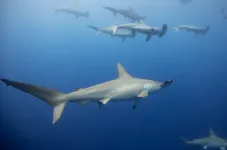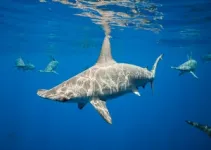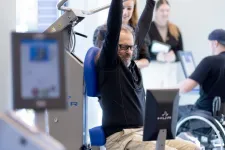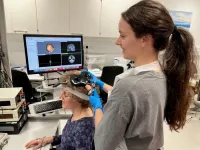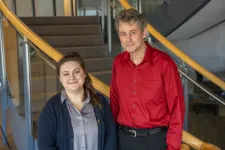(Press-News.org) Scalloped hammerhead sharks hold their breath to keep their bodies warm during deep dives into cold water where they hunt prey such as deep sea squids. This discovery, published today in Science by University of Hawai‘i at Mānoa researchers, provides important new insights into the physiology and ecology of a species that serves as an important link between the deep and shallow water habitats.
“This was a complete surprise!” said Mark Royer, lead author and researcher with the Shark Research Group at the Hawai‘i Institute of Marine Biology (HIMB) in the UH Mānoa School of Ocean and Earth Science and Technology. “It was unexpected for sharks to hold their breath to hunt like a diving marine mammal. It is an extraordinary behavior from an incredible animal.”
Shark gills are natural radiators that would rapidly cool the blood, muscles, and organs if scalloped hammerhead sharks did not close their gill slits during deep dives into cold water. These sharks are warm water animals but feed at depths where seawater temperatures are similar to those found in Kodiak Alaska (around 5ºC/ 40ºF), yet they need to keep their bodies warm in order to hunt effectively.
“Although it is obvious that air-breathing marine mammals hold their breath while diving, we did not expect to see sharks exhibiting similar behavior,” said Royer. “This previously unobserved behavior reveals that scalloped hammerhead sharks have feeding strategies that are broadly similar to those of some marine mammals, like pilot whales. Both have evolved to exploit deep dwelling prey and do so by holding their breath to access these physically challenging environments for short periods.”
The research team discovered this unexpected phenomenon by equipping deep-diving scalloped hammerhead sharks with devices that simultaneously measured their muscle temperature, depth, body orientation, and activity levels. They saw that their muscles stayed warm throughout their dive into deep cold water but suddenly cooled as the sharks approached the surface toward the end of each dive. Computer modeling suggested that hammerhead sharks must be preventing heat loss from their gills to keep their bodies warm during these deep-dives into cold water.
Additionally, video of a scalloped hammerhead shark swimming along the seabed at a depth of 1,044 meters (more than 3,400 feet) showed its gill slits tightly closed, whereas similar images from surface waters show these sharks swimming with their gill slits wide open. A sudden cooling in muscle temperature as scalloped hammerhead sharks approach the surface at the end of each dive suggests that they opened their gill slits to resume breathing while still in relatively cool water.
“Holding their breath keeps scalloped hammerhead sharks warm but also shuts off their oxygen supply,” said Royer. “So, although these sharks hold their breath for an average of 17 minutes, they only spend an average of four minutes at the bottom of their dives at extreme depths before quickly returning to warmer, well-oxygenated surface waters where breathing resumes.”
“This discovery fundamentally advances our understanding of how scalloped hammerhead sharks are able to dive to great depths and withstand frigid temperatures in order to capture prey,” said Royer. “It also demonstrates the delicate physiological balance that scalloped hammerhead sharks must strike in order to forage successfully.”
Scalloped hammerhead sharks are not listed as threatened in Hawaiʻi but are regionally endangered in other parts of the world due to overfishing, bycatch, and nursery habitat loss.
“This new and detailed understanding of scalloped hammerhead physiology and ecology enhances our ability to effectively manage and conserve this iconic species by revealing potential vulnerabilities associated with changing ocean conditions or future human exploitation of these deep foraging habitats, such as deep-sea mining or large-scale fishing in the mesopelagic “twilight zone”, both of which might make it harder or more dangerous for these sharks to hunt their natural prey,” said Royer. “This extraordinary physiological feat that allows scalloped hammerhead sharks to expand their ecological niche into the deep sea could very well make them vulnerable to additional human impacts.”
END
Hammerhead sharks hold their breath on deep water hunts to stay warm
2023-05-11
ELSE PRESS RELEASES FROM THIS DATE:
The feeling of hunger itself may slow aging in flies
2023-05-11
From low-carb to intermittent fasting, surgery to Ozempic—people turn to a seemingly never-ending array of diets, procedures and drugs to lose weight. While it has been long understood that limiting the amount of food eaten can promote healthy aging in a wide range of animals, including humans, a new study from University of Michigan has revealed that the feeling of hunger itself may be enough to slow aging.
Previous research has demonstrated that even the taste and smell of food can reverse the beneficial, life-extending effects of diet restriction, even without its consumption.
These intriguing findings drove first author Kristy Weaver, Ph.D., principal investigator ...
Nature is changing as land abandonment increases
2023-05-11
When people leave their rural lives behind to seek their fortunes in the city or agriculture is no longer profitable, the lands they toiled on are often left unused. A new perspective piece in Science shows that these abandoned lands could be both an opportunity and a threat for biodiversity, and highlights why abandoned lands are critical in the assessment of global restoration and conservation targets.
The past 50 years have seen an increased exodus of populations from rural to urban areas. Today, 55% ...
First-of-its-kind measurement of the Universe’s expansion rate weighs in on a longstanding debate in physics and astronomy
2023-05-11
Thanks to data from a magnified, multiply imaged supernova, a team led by University of Minnesota Twin Cities researchers has successfully used a first-of-its-kind technique to measure the expansion rate of the Universe. Their data provide insight into a longstanding debate in the field and could help scientists more accurately determine the Universe’s age and better understand the cosmos.
The work is divided into two papers, respectively published in Science, one of the world’s top peer-reviewed academic journals, and The Astrophysical Journal, a peer-reviewed scientific journal of astrophysics and astronomy.
In astronomy, there are two precise ...
Historic achievement for international penile cancer trial--100 patients enrolled thus far, the most ever to a prospective study for treatment of an extremely rare disease
2023-05-11
Cancer of the penis is not a subject that comes up in conversation. When it does, one common response is, “I didn’t know you could get cancer there.” Not only is it not spoken about, but it is also rare, with fewer than one case per 100,000 men diagnosed in developed countries like the United States and the United Kingdom per year. That rarity has meant far fewer clinical trials have been developed and conducted to guide its treatment, and in most cases, only small numbers of patients have been included. Fortunately, researchers from both sides ...
Getting active, while living with a partial spinal cord injury
2023-05-11
A UBC Okanagan researcher has been testing the effectiveness of a mobile app that encourages people living with a spinal cord injury—but can walk—to get active.
Dr. Sarah Lawrason, a researcher in the School of Health and Exercise Sciences, has focused her career on working with people who live with a spinal cord injury (SCI) but are ambulatory. She describes this population as an isolated, often misunderstood group of people because while they live with an SCI, they may not rely on a wheelchair all of the time for mobility.
“When people think of someone with an SCI, they picture a ...
New, free online language course helps you learn Ojibwe
2023-05-11
TORONTO – May 11, 2023 – With funding from Canada’s Social Sciences and Humanities Research Council (SSHRC), Baycrest, the Kingston Indigenous Language Nest (KILN) and the University of Toronto have released a free online language course to learn the Indigenous language Ojibwe, also known as Anishinaabemowin.
The Ojibwe language is spoken in Indigenous communities around the Great Lakes in Canada and the US, but serious efforts are needed to ensure the long-term survival of the language.
“Due to the aging of people who ...
New research sheds light on the causes of fatigue after COVID 19
2023-05-11
Experts from Newcastle University found the nervous system of people with post-Covid fatigue was underactive in three key areas. Fatigue is one of the most common symptoms of long Covid.
The breakthrough could lead to better treatment and tests to identify the condition and the team are already progressing the work having just started a trial. They have begun recruiting patients to test the effectiveness of a TENS machine – commonly used for pain relief in childbirth – to alleviate the fatigue in patients with long Covid.
Newcastle University ...
Into the Blue: Securing a sustainable future for kelp forests
2023-05-11
Into the Blue: Securing a Sustainable Future for Kelp Forests global synthesis report is the most comprehensive knowledge review on kelp to date, revealing the state of science on the world’s kelp forests and providing recommended actions to build the recovery of the world’s kelp forests.
Aiming to improve our understanding of the value of kelp forests and provide recommendations to protect and sustainably manage them, the report also provides a range of policy and management interventions and options that can be used to maintain these remarkable ecosystems into the future and to support the people and economies that have depended on them for generations.
Despite ...
Heavy drinking poses even greater risk for one in three Americans
2023-05-11
LOS ANGELES — Two people regularly have a few alcoholic drinks daily. One develops liver disease. The other doesn’t.
What explains the different outcomes?
The answer may lie in a condition known as metabolic syndrome, a cluster of conditions that together raise the risk of coronary heart disease, diabetes, stroke and other serious health problems. This syndrome, characterized by symptoms such as abdominal fat, high blood pressure, high cholesterol and high blood sugar, affects more than one in three Americans.
A new ...
Gene linking circadian and circatidal rhythms is discovered in tiny crustacean
2023-05-11
Scientists at UMass Chan Medical School and the Marine Biological Laboratory at Woods Hole have identified the first gene—Bmal1—to play a crucial role in regulating circatidal behavior in the crustacean Parhyale hawaiensis. Circatidal rhythms help animals cope with the rise and fall of the tides in coastal areas.
Published in Current Biology, the study by neurobiologists Patrick Emery, PhD, Joshua Rosenthal, PhD, and colleagues demonstrates the first molecular link between circatidal and circadian ...
